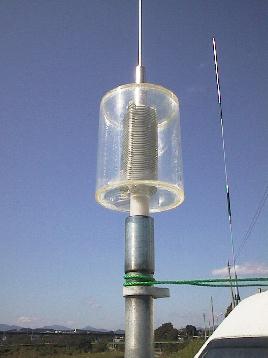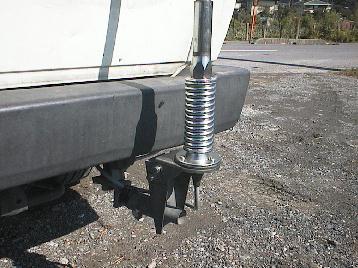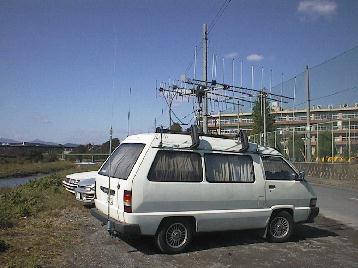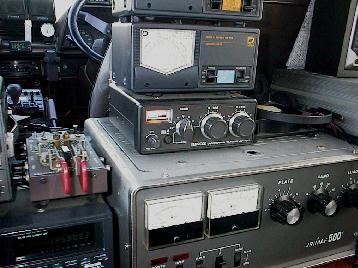Mobile QSO

[The last renewal of this page: June 28, 1993]
1. Operations on VHF/UHF Bands
Everything is simple on VHF for the mobile operation. Recent popularization of the cellular phones get its
merit lowered. However, it is till necessary for short distance communications for the Ham's vehicle,
 50MHz
50MHz
Although the noise level is high, as the influence of the buildings and landform is relatively small, we can extend
the distance more than expected.
 144MHz
144MHz
This band has merits of both 50MHz and 430MHz, and is the best choice for the mobile QSO using the grand wave.
Only the problem is that so many stations are on, and is hard to find a clear frequency in a city area.
 430MHz
430MHz
Noise level is very low, and the band is very quiet. The band width is wide, and is getting popular now. A lot of
repeater systems are also available. If you have 144MHz and this band, you would't have no problem at all to find
a party to talk to whereever you go.
 1200MHz
1200MHz
Hard to detect the noise, and band is wider, but it gets much influence from the buildings and landform, and
rainy weather attenuates the radio wave. These defects make the contacts difficult. It is nice to use this
band for the contacts between mobiles driving together. QSOs via the repeaters are good compromise.
2. Operations on HF Bands
 1.9MHz
1.9MHz
With the whip antenna of 3 meter(10 foot) long, the efficiency is too low and would be no use actually.
Phone mode is not allowed, so the operations is limited on CW.
 3.5/3.8MHz
3.5/3.8MHz
The efficiency of the antenna is still low for the wave length of these bands. It is possible to improve it, but the
contacts would be limited in short distance.
 7MHz
7MHz
Good for the short distance contacts less than 1,000Km. In spite of the efficiency of the antenna is low, it is amazing
that you can reach to the station that you can hear. Bad width is narrow, especially in Japan, and due to heavy heavy
QRM, long QSO is very difficult.
 10MHz
10MHz
Althougn only the CW is allowed, good for DX. I have an experience to work Africa cutting through pile-up while I was
driving on a highway.
 14MHz
14MHz
No doubt that the band is the best for any distance. I have many experiences that I enjoyed rag-chew for more than an
hour driving around. If you have to choose only one band from HF, this band will be the best answer.
 18MHz
18MHz
As long as the sun spot numbers is high, it is as good as 14MHz.
 21MHz
21MHz
As long as the sun spot numbers is high, signals are stronger than 14MHz. The band width is wider, and many stations are on.
 24MHz
24MHz
Only when the sun spot numbers is very high, this band will be nice for any distance, although the opening
is rather sporadic.
 28MHz
28MHz
This band is active only when the sun spot number is very high. Band width is very high, and once the band
is opened, many stations will be on. While the band is opened, the signal strength is unbelievably strong.
Opening is very sporadic, and a long rag-chew would be limited. As the FM mode is allowed on this band,
even when the sun spot numbers is low, you can enjoy local QSOs on FM.
3.The system of the Mobile station for HF bands
TRANCEIVER
Nowadays, we can find a lot of small tranceivers which work with 13.8V
DC in the market, and will have any problem like we used to have many
years ago. Many people seem to be using a separate-pannel type tran-
ceiver recently for this purpose, however, I recommend you to use a
small sized desktop type tranceiver if you have a enough space to mount
it at the front seat, as it is easier to operate as you drive a car. A
powerful external speaker system is recommended as you have a noise in
your car.(If you have a super sedan, you might not have this problem!)
CW KEYER
If you operate CW, you need this, of course. If you practice for a
while, sending Morse codes while you are driving will not be a problem
at all. If your car is a sedan, you have to think where you can set the
keyer, but like me, if you have a wagon you can set the thing easily. I
set the keyer at the right front corner, (If your car has a steering on
your right hand)above the driving pannel with the dualside bonding tape.
I can easily operate it with normal driving position with just streching
my arm to it.
MICROPHONE
If your car is an automatic-shift type, you may use a handheld microphone
however, if your car is a manual-shift type, you may need a microphone
with a flexible boom pipe which is fixable to the ceiling or suitable
place nearby. In QSO on V/UHF FM radio, even if you remove your handheld
microphone from near your mouse for shifting a gear ratio of the car,
people waits till you come back as the carrier goes out contimuously
during your transmission. However, on HF, with SSB, people wonders if
you have turn the microphone back to him or not in the same situation,
and from time to time you'll be doubled.
ANTENNA
What you have to think about most is the antenna. This is where you can
proud of your technology! If you'll be satisfied with just being able to
have some contact, compact antennas being sold anywhere in the market
would be fine, otherwise you need some idea for your own antenna system.
Important thing is, make it large, as large as possible under your
conditions including the size of your car. What we have to do is, make
it smaller from the original size, which is relatively very large. In
another word, we are forced to cut down the efficency of the original
antenna. So, the theme is how to minimize the this problem.
For the base unit, you should select a heavy metal base unit which is
fixed to the traction hook of the car, rather than a light metal base
unit which is fixed to the bumper of the car. You should mount the long
element, as long as possible, to it. After that, you have two choices as
CHOICE 1 and CHOICE 2 as below.
 CHOICE 1 : Would like to work all bands, but not seriously.
CHOICE 1 : Would like to work all bands, but not seriously.
You'd better to buy a full-automatic all frequency antenna tuner. With
this stuff, you can get good resonance in all bands, and thus, you can
work in all band. The performance should be worse than the method in
CHOICE-2 stated as bellow, but you can enjoy it especially above 14MHz.
The antenna system that you have to change the band switch or exchange
the coil or element, getting out of the car everytime you want to change
the band is not recommendable, as it is so inconvenient.
 CHOICE 2 : Select one band with the best performance.
CHOICE 2 : Select one band with the best performance.
a. At the highest point of the element,
b. Insert the loading coil largest(highest Q) as possible.
These two point is the theory. To get the maximum performance, use the
matching transformer with the troydal core, or the small antenna tuner
like AT120, AT-130 ( in case of KENWOOD) which you can find in a junk
box or junk shop, and get the 100% matching.
Especially in low bands (Lower than 7MHz), this method is essential.
Actually, we can observe many stations in 3.5MHz have done a great
effort regarding the points a & b stated above.
 My Antenna System
My Antenna System
In my case, I have tried many anttenas in the past, and after all, the
final method which I'm using recent years are as follows;
Build the monoband antenna according to the CHOICE-2 first, and then,
mount the fullautomatic all frequency antenna tuner stated in CHOICE-1.
With this stuff, I can work 14MHz(My main band) with the best performace
and also I can enjoy all other bands.
Pictures below shows the most current status of my mobile antenna system
using a manual controled antenna tuner. As my QRV is almost limited to
14MHz only, I changed the tuner to a manual tuner. This provides a
complete tuning and less RF feedback problems to other electric equipment
in a car.

The Airdax-Coil(Old commercial made coil) from my junk-box is set in a
plastic case, which I bought in the Tokyo Ham Fair 98'. The element
consists of sevral different parts that I had bought in different occa-
sions, being assembled so that the pitch of the screws fit each other.
A green string is for support the element from the front, to privide no
accidental movement of the element while its driving.

A base is a spring type being fixed to the hook for the traction. This
provides a stable setting, and enables longer element to be set. The
connection between the element and the base is a M-type RF connector,
which enebles easier installation and uninstallation of the element and
is preferable to a volt type connection.

Element length is more than 3meters (10feet). (Thick alminium tube is
used under the coil, and a stainless whip is used above the coil.)

As a whip antenna, especially when it is shortened with a coil, an impedance
at feeding point never matches to that of coax cable. A matching
box right close to the feeding point is desired, but an old antenna tuner
(KENWOOD AT-130) inserted somewhere in the coax cable is fine as you have
just a short distance coax cable to the feeding point in a car.
Tuning it at the center of the band, (Once you tuned it, you'll never need to adjust
it again), SWR 1 to 1.3 is provided from 14.100MHz to 14.300MHz. Between
14.150 to 14.250, SWR is almost 1 to 1. (Without the tuner, SWR at resonanced frequency remains 1 to 1.5)


 In case you hit this
page directly from a Search Engine, you can reach to all of the pages of MAFNET from Top Page
In case you hit this
page directly from a Search Engine, you can reach to all of the pages of MAFNET from Top Page
 50MHz
50MHz
 144MHz
144MHz
 430MHz
430MHz
 1200MHz
1200MHz
 1.9MHz
1.9MHz
 3.5/3.8MHz
3.5/3.8MHz
 7MHz
7MHz
 10MHz
10MHz
 14MHz
14MHz
 18MHz
18MHz
 21MHz
21MHz
 24MHz
24MHz
 28MHz
28MHz
 CHOICE 1 : Would like to work all bands, but not seriously.
CHOICE 1 : Would like to work all bands, but not seriously.
 CHOICE 2 : Select one band with the best performance.
CHOICE 2 : Select one band with the best performance.
 My Antenna System
My Antenna System



